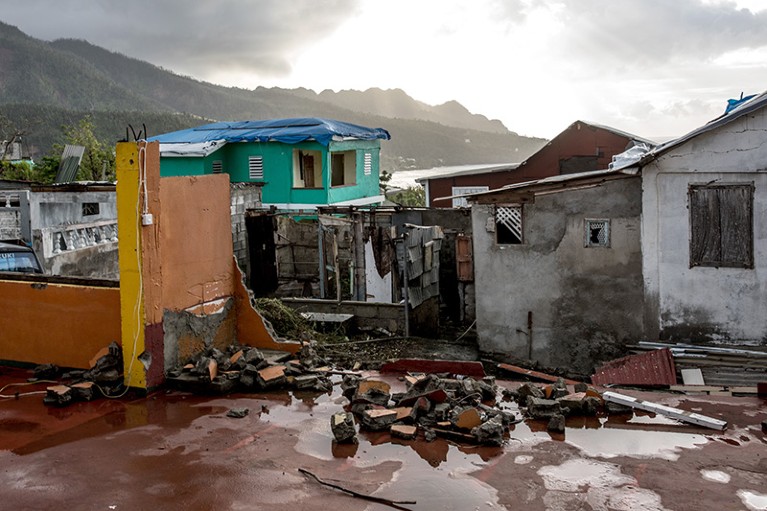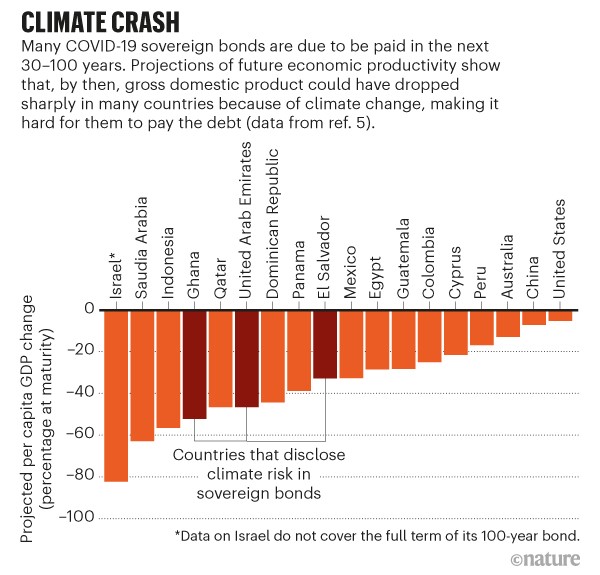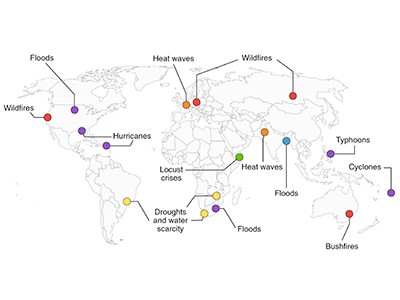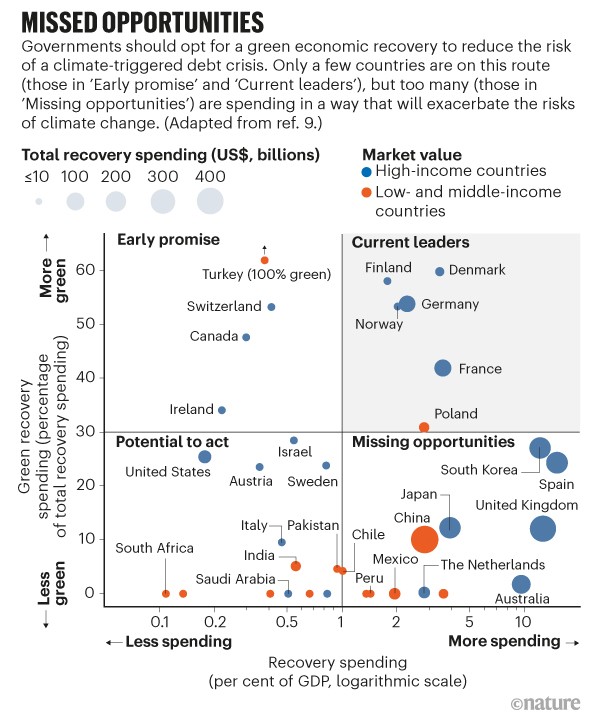
The effects of Hurricane Maria in Dominica in 2017 caused millions of dollars’ worth of damage to the country’s economy.Credit: Alejandro Cegarra/Bloomberg via Getty
Most governments’ astronomical borrowing during the current pandemic pays scant attention to the effects that climate change could have on their ability to repay the debt. Here we present an analysis of countries’ sovereign debt issued in 2020, showing that the vast majority of nations did not disclose the ways in which global warming might alter their credit-worthiness.
This is concerning. Even the anticipation of a climate shock might cause a debt crisis. If financial markets misprice the current risk, an event in one country could awaken investors’ sensitivity, triggering a synchronized revaluation of sovereign debt everywhere.
This vulnerability can be avoided if climate risks are properly assessed and disclosed by governments that are issuing sovereign bonds to raise money, and if the money borrowed is spent on greening countries’ economies. As of early March 2021, around half of the COVID-19 stimulus funding that wealthy G20 countries had paid to the energy sector — roughly US$250 billion — had gone towards fossil fuels, rather than to cleaner energy sources (see go.nature.com/2qrratf).
Without more transparency, investors could demand a higher interest rate or refuse to lend entirely. In February, BlackRock, one of the world’s largest asset-management firms, set a “strategic preference” for developed markets, citing the risk of climate exposure in low- and middle-income nations and their more carbon-intensive economies1.
As policymakers convene to discuss the most pressing economic challenges at this week’s Spring Meetings held by the International Monetary Fund (IMF) and the World Bank, researchers and governments should take steps to achieve a climate-resilient recovery. This includes three approaches set out here to avoid COVID-19 lending that compounds the climate and debt crisis2. Countries should come clean about their climate exposure when taking on COVID-19 debts. Pricing in these risks would incentivize investments that would reduce the impact of climate change.
Sovereign debt
For centuries, governments have issued sovereign bonds (rather like an IOU) to raise money from domestic or international investors. This allows governments to spend on projects or policies that increase economic productivity, without increasing taxes in the short term. The interest rate is set by the market to compensate investors for the perceived risk involved in lending to governments: the higher the risk of default, the higher the borrowing costs. That is why, in 2020, a 30-year bond from El Salvador, a lower-middle-income country, was priced with an interest rate of close to 10%, whereas one from a stable high-income economy such as Spain was closer to 1%.
Judiciously borrowing money to increase economic output can allow countries to earn a return that is greater than their costs in servicing debt. As the economy grows and tax receipts rise, governments can repay investors and spend on public services, such as health care or education. For this reason, sovereign bonds were the most significant instrument in the debt capital markets before the pandemic, accounting for nearly half of the $115-trillion global bond market in 2019. During 2020, wealthy countries issued additional bonds worth tens of trillions of dollars, and emerging economies issued hundreds of billions’ worth3.
Net-zero emissions targets are vague: three ways to fix
Borrowing money that does not lead to economic growth can be damaging. An unexpected shock to the economy, such as COVID-19, can disrupt growth and make heavily indebted countries vulnerable to defaulting on their loans. Governments must then spend to service their debts, rather than invest in serving their citizens. Alternatively, governments can borrow more money, but if investors anticipate increased risk, they might charge a higher interest rate. The current pandemic poses a major problem to the global economy. As of July 2020, a ‘debt tsunami’ of $130 billion was owed to creditors by more than 100 low- and middle-income countries. Half of this is owed to private lenders4. Development finance institutions, such as the World Bank and the IMF, have called on government creditors to suspend their debt-service obligations from the world’s poorest nations in light of the COVID-19 crisis (see go.nature.com/3cjyxwb). But private holders of sovereign bonds are generally less willing to simply waive debt. The consequences can be severe. In 2020, Zambia, Argentina, Belize, Ecuador, Lebanon and Suriname defaulted, with the result that they now have troubled relationships with their creditors and might have to face austerity to manage repayments.
We analysed legal documents governing private-sector lending to countries during the COVID-19 pandemic, and estimate that $783 billion has been borrowed through sovereign bonds that mature 30, 50 or even 100 years from now (see Supplementary Information, SI). During this timeframe, governments will either have to invest to mitigate climate change as part of their commitments under the Paris climate agreement — which could require a far-reaching decarbonization of the economy — or face the costs of global warming directly. Either way, this risk will affect governments’ ability to repay or refinance outstanding debt.
Climate change has the potential to severely affect a country’s economy. Over the 30–50-year period covered by much of the COVID-19 lending, changes in global average temperatures alone could lead to gross domestic product (GDP) falling by tens of percentage points in some countries5. For instance, when Saudi Arabia’s bonds mature in 2060, lower productivity in the country could cause its GDP to drop by 60% relative to scenarios without climate change5 (see SI). These calculations are possibly conservative because they exclude potentially significant impacts, such as more-intense and more-frequent extreme events6. When Hurricane Maria hit Dominica in 2017, it caused damage worth an estimated 220% of GDP. This left the government little room for spending other than on recovery.
Undisclosed risks
Our analysis shows that 77% of the sovereign-bond prospectuses we reviewed did not disclose any climate-related risks. We examined the publicly available prospectuses of sovereign bonds and notes issued in 2020, which mature in or after 2050. This comprised 50 issuances from 26 countries (see ‘Climate crash’).

Source: Ref. 5
How should governments make such disclosures? The recommendations of the Task Force on Climate-related Financial Disclosures (TCFD)7, which are now widely used by companies, suggest that corporations analyse two categories of risk and report them to financial markets. One is physical risks, which consider how projected changes in the climate will impact corporate productivity. The other is transition risks, which encompass how climate-related changes in markets and government policy will affect the company’s asset values and strategies as nations move to lower-carbon economies. Although a country-specific framework for climate-risk reporting will differ from the corporation-focused TCFD recommendations, governments should still evaluate and report their physical and transition risk exposures to debt markets.
We found that only three governments (those of Bermuda, the Dominican Republic and El Salvador) acknowledged that more-frequent major weather events will create physical risks for their economies. Only two — those of Bulgaria and the United Arab Emirates — identified the risks of transitioning their economies to reduce emissions. And only Ghana disclosed the impacts of both types of risk on its ability to repay.
Form a climate club: United States, European Union and China
Given the severity of these climate risks, governments should assess and disclose them when they borrow money. A bank will ask a customer countless questions before giving them a loan, and will charge a higher rate of interest if it thinks the individual will struggle to repay. Similarly, securities law and bond-listing rules in debt capital markets require governments to include statements disclosing risk factors that could undermine their ability to make repayments. These often outline the possibility of regional geopolitical instability, wars and civil strife. Investors rely on these disclosures to assess whether the risks are balanced by the returns (in the form of interest rates) in lending to a country. This is particularly important when a government is involved. If an investor loans money to a corporation, the investor usually has legal ‘sticks’ available to ensure they get their money back, including an ability to seize the company’s assets if they default. But because of a legal doctrine called sovereign immunity, investors can rarely seize the assets of a government.
Even when climate-related disclosures were made in the sovereign bonds, we found that the information provided was limited. For instance, Bermuda simply reports on the possibility of major hurricanes and tropical cyclones occurring, and notes among others the 2019 Category 3 Hurricane Humberto, which caused tens of millions of dollars’ worth of damage. Bulgaria’s prospectus discusses the impact of the European Union’s ambitious net-zero emissions commitment on the country’s coal industry, given that “the country produced and processed approximately 7 per cent of the EU’s coal and represented approximately 7 per cent of the jobs in the EU’s coal sector in 2018”.
The gaps we found suggest that governments do not understand the economic impacts of climate risks or are unwilling to report them. Both explanations are troubling, and could have significant consequences for debt sustainability and climate policy.
Flying blind
Without rigorous climate disclosures, investors and governments are flying blind. The United Nations secretary-general warned in March that “we are on the verge of a debt crisis”. Evidence is mounting that a severe future climate shock, such as a long-term drought in a country reliant on agriculture or the collapse of fossil-fuel industries, could cause government defaults and a credit crisis8. Revaluations in anticipation of such an event could also trigger this.
Emissions are still rising: ramp up the cuts
Such an event could lead to higher borrowing costs for vulnerable governments, or even exclusion from commercial debt markets. It might also cause investors to withdraw from the country, just when it needs more external capital to respond to the climate shock. This ‘capital flight’ can wreak havoc in low- and middle-income countries, as evidenced by the Latin American debt crisis of the 1980s. Future generations, particularly in the poorest countries, could end up trapped in debt and poverty, aggravated by a warming world. Then it would be down to development finance institutions — and taxpayers in the wealthy countries that provide them with capital — to avert humanitarian and economic disaster.
A revaluation of sovereign debt would hit the most vulnerable countries the hardest. In the context of companies, it might actually be desirable for investors to redirect their capital away from the carbon-heavy industries of the past and towards the greener sectors of the future. As investment shifts to new industries, it enables innovation and job creation so that people can follow. In fact, this rationale underpins much of green finance, as well as many disclosure-based initiatives, such as the TCFD.
But such transitions have vast human and economic costs, particularly for government borrowers. Countries — unlike companies — cannot simply cease to exist when bankrupt. Instead, current and future citizens will bear the cost of debt burdens for generations. Moreover, many of the poorest nations, which have contributed least to climate change, are those most exposed to it. Better pricing of that risk would, by itself, only raise the cost of capital for these countries to finance decarbonizing and resilience-enhancing policies.
For this reason, countries can have a strong (short-term) disincentive against disclosing their climate risk exposures. However, as investors increasingly demand such disclosures as a condition for investment, and as countries face the costs of climate change, such a strategy could expose governments to sudden increases in borrowing costs. A gradual adjustment would be much less disruptive. Yet it is clear that better disclosure of climate risk will not be enough by itself to address the challenges that low- and middle-income countries face.

The United Arab Emirates is increasingly producing home-grown crops, such as these greenhouse tomatoes, with the aim of reducing emissions from imports and improving its resilience to the impacts of climate change on food supplies.Credit: Christopher Pike/Bloomberg via Getty Images
Wealthier countries are not incentivized to spend their COVID-19 recovery funds sensibly, because their cost of capital does not reflect climate-change risks. So far, only 18% of total announced COVID-19 recovery spending is directed to activities that will reduce global emissions9. And long-term recovery spending is only 13% of the total; most spending is for rescue rather than recovery purposes, and rescuing perpetuates the existing emissions-intensive global economy. Despite calls to ‘build back better’, governments have financed activities that are damaging to the climate, including at least $6.9 billion on new coal infrastructure in India, and Germany’s $9.98-billion unconditional bailout of its major airline, Lufthansa10. Rather than creating prosperity and facilitating debt repayment, investing in outdated fossil-fuel technologies leaves future generations with more debts, higher cost of capital, stranded assets and even greater warming.
Together, these spending patterns could create a vicious cycle of COVID-19 debt, climate impacts and credit risks (see Supplementary Figure S1).
Three steps
Researchers, governments and financial institutions should take three straightforward steps to remedy the situation.
First, they must work together to better assess, disclose and manage vulnerability to sovereign climate risk. Part of the reason climate risk is not better reported by governments and priced by investors is that they do not have the right tools. In a 2020 report11, international financial regulators and experts wrote that governments need to make an “epistemological break” with their old analytical methods for forecasting economic risk, to deal with the non-linear and radically uncertain nature of sovereign climate risk. Researchers should help to develop these methods, particularly with respect to sovereign transition risk, and conduct country- and sector-specific analyses on how climate risks are transmitted.
Key questions include: how can better scenarios be developed to evaluate socio-economic transitions? How fast could the structure of energy production and prices change12? How will productivity in various sectors be affected by changes in temperature? Modelling methods need to be further developed to answer these questions. These should account for uncertainty; the implications of aggregation, heterogeneity and distribution; and technological change. Most importantly, they should include realistic damage functions for the economic impact of climate change13.
Compound climate risks in the COVID-19 pandemic
This large-scale undertaking can be achieved through small steps. Mandatory climate disclosures for companies and asset managers, currently under way in many jurisdictions including the EU, New Zealand and the United Kingdom, can kick-start the development of a broader information environment around climate risks14. A standardized reporting framework tailored to countries rather than companies, similar to the TCFD, could be developed. Once that is in place, stock exchanges could update listing guidance and standardized rules for climate risk disclosure in debt markets. Finally, to produce the necessary data and manage exposures, governments should improve their coordination of climate and financial policy across departments. A broad group of government agencies will be needed to account for climate risk, including central banks, financial regulators, finance and agriculture ministries and disaster-preparedness agencies all feeding into the advisory process for debt management.
Second, governments should use COVID-19 credit to mitigate climate risk, build climate resilience and expand the economy to aid future debt repayment15. The Biden administration’s forthcoming recovery plan includes such a ‘build back better’ strategy. Government spending on cheap clean energy, for instance, can reduce emissions, create jobs and stimulate economic growth. Every citizen should ask whether their country’s COVID-19 recovery package is green enough. Some countries, including South Korea, the United Kingdom and Australia, are missing out (see ‘Missed opportunities’). There is still the potential to act, and governments in the United States, Canada, Switzerland and many more should seize this opportunity. The advent of green sovereign bonds, which incentivize the borrower to use funds for green purposes such as reducing emissions, and the attention which credit agencies pay to measuring resilience, suggest that bond markets will reward such efforts with lower interest rates.

Source: Ref. 9
Third, wealthier lender countries and their development finance institutions should provide financial support to the most vulnerable borrower countries. The institutions should buy back debt from heavily indebted poorer countries, on the condition that the money is used to increase climate resilience rather than servicing the debt16. Debt-for-nature swaps have been used in the Seychelles, for instance, with the UN Development Programme and other agencies reducing the country’s debt burden in exchange for the government’s investment in climate resilience and biodiversity projects. Nature-performance bonds, which tie the cost of debt repayments to quantified emissions-reductions targets or nature-based targets, represent a more flexible evolution of such swaps. These bonds could encompass a wider range of investments that can be readily scaled up, such as those for decarbonizing electricity production.
These three measures could help governments to ensure that the credit needed to fight COVID-19 does not exacerbate the climate crisis, resulting in a credit crunch for future generations. They will have enough to deal with.

 Form a climate club: United States, European Union and China
Form a climate club: United States, European Union and China
 Net-zero emissions targets are vague: three ways to fix
Net-zero emissions targets are vague: three ways to fix
 Emissions are still rising: ramp up the cuts
Emissions are still rising: ramp up the cuts
 How do natural hazards cascade to cause disasters?
How do natural hazards cascade to cause disasters?
 Put people at the centre of global risk management
Put people at the centre of global risk management
 Compound climate risks in the COVID-19 pandemic
Compound climate risks in the COVID-19 pandemic
 Global warming will happen faster than we think
Global warming will happen faster than we think
 Emissions: world has four times the work or one-third of the time
Emissions: world has four times the work or one-third of the time







